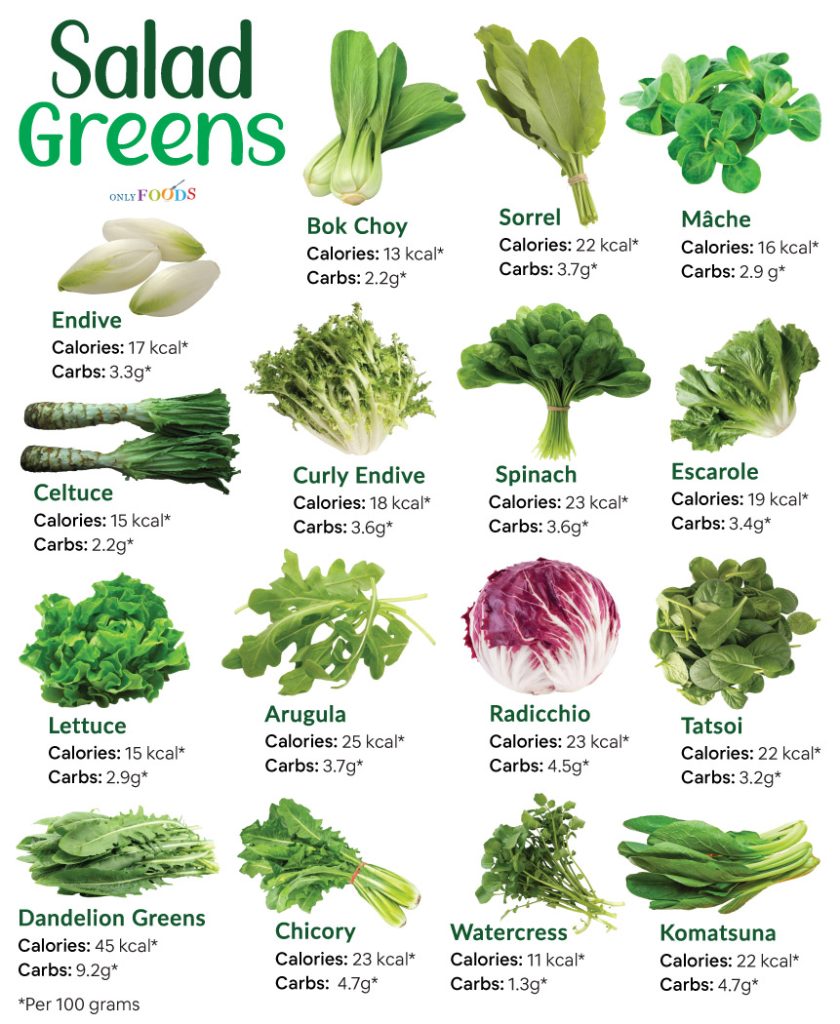Salad Greens
Leafy greens that are eaten raw in salads are called salad greens, or sometimes colloquially, salad leaves. Though the term usually brings lettuce to mind, plenty of other greens make equally delightful additions to raw salads.
Salad greens are a great source of fiber, vitamins like A, C, D, K, and minerals like potassium and calcium. Most of them are also rich in various B vitamins, including folate. For example, lettuce and spinach are rich in vitamins K and A. Additionally, spinach is a noteworthy magnesium, iron, and folate source.
Being low in carbs, calories, and sodium also helps make them a healthy food choice.
List of Different Types of Salad Greens
It is challenging to decide on a single salad green as the ‘healthiest’ because each contains different nutrients that can affect the body differently. The following table lists salad greens based on how commonly they are available, along with information on how much carbs and calories each has. And since a salad is all about its diverse ingredients, it’s crucial to know what to mix with specific greens to truly savor the flavors.
| Name | Calories per 100g | Carbs per 100g | Flavor & Texture | Combines Well With |
|---|---|---|---|---|
| Lettuce | 15 kcal | 2.9g | Mild, refreshing, crisp | Tomatoes, Cucumbers, Avocado |
| Spinach | 23 kcal | 3.6g | Mild, slightly sweet, tender | Strawberries, Feta, Walnuts |
| Arugula (Rocket) | 25 kcal | 3.7g | Peppery, nutty, crisp | Parmesan, Pine Nuts, Cherry Tomatoes |
| Kale | 49 kcal | 8.8g | Earthy, hearty, chewy | Apples, Pomegranate Seeds, Almonds |
| Watercress | 11 kcal | 1.3g | Peppery, slightly bitter, crisp | Citrus (Orange, Grapefruit), Goat Cheese, Walnuts |
| Swiss Chard | 19 kcal | 3.7g | Earthy, slightly bitter, tender | Garlic, Lemon, Raisins |
| Radicchio | 23 kcal | 4.5g | Bitter, bold, crunchy | Gorgonzola, Walnuts, Balsamic Vinaigrette |
| Endive | 17 kcal | 3.3g | Bitter, crisp, slightly sweet | Blue Cheese, Pear, Pecans |
| Curly Endive (Frisée) | 18 kcal | 3.6g | Bitter, curly, crunchy | Bacon, Goat Cheese, Apples |
| Mizuna | 13 kcal | 2.2g | Peppery, mild | Sesame Seeds, Soy Sauce, Scallions |
| Tatsoi | 22 kcal | 3.2g | Mild, spinach-like | Ginger, Soy Sauce, Rice Vinegar |
| Escarole | 19 kcal | 3.4g | Bitter, broad, tender | White Beans, Lemon, Parmesan |
| Sorrel | 22 kcal | 3.7g | Tangy, lemony, tender | Strawberries, Goat Cheese, Almonds |
| Chicory | 23 kcal | 4.7g | Bitter, crunchy, slightly sweet | Blue Cheese, Pears, Walnuts |
| Collard Greens | 32 kcal | 5.4g | Robust, chewy, slightly bitter | Ham, Black-Eyed Peas, Vinegar |
| Mustard Greens | 27 kcal | 5.8g | Peppery, pungent, tender | Bacon, Hard-Boiled Eggs, Red Onions |
| Cabbage | 25 kcal | 6g | Mild, crunchy, dense | Carrots, Apples, Ginger |
| Celtuce (Asparagus Lettuce) | 15 kcal | 2.2g | Mild, crisp, slightly sweet | Sesame Oil, Soy Sauce, Garlic |
| Komatsuna (Tender leaves) | 22 kcal | 4.7g | Mild, tender, mustard-like | Rice Vinegar, Sesame Seeds, Tofu |
| Corn Salad (Mâche) | 16 kcal | 2.9g | Nutty, mild, tender | Radishes, Cherry Tomatoes, Goat Cheese |
| Beet Greens | 22 kcal | 4.3g | Earthy, slightly bitter, tender | Goat Cheese, Walnuts, Oranges |
| Dandelion Greens | 45 kcal | 9.2g | Bitter, peppery, crisp | Blue Cheese, Bacon, Pomegranate Seeds |
| Bok Choy | 13 kcal | 2.2g | Mild, crisp, juicy | Soy Sauce, Ginger, Sesame Oil |
| Napa Cabbage | 12 kcal | 2.2g | Mild, crunchy, slightly sweet | Soy Sauce, Ginger, Garlic |
Despite the name, not all salad ‘greens’ are green. Radicchio has a dark purple color, while the red salad bowl lettuce cultivar has an attractive red color.
Younger or ‘baby’ salad greens, like baby spinach and baby kale, are tenderer and more suitable to be eaten raw in salads.
FAQ
Examples of bitter-tasting salad greens include kale, turnip greens, radicchio, collard, and mustard greens. The bitterness is a result of the presence of certain compounds in plants from the Brassica family.
Though not the most common way to eat them, salad leaves can be added to stir-fries and braised dishes. It can be an excellent way to use up leftovers. Sautéing the leaves for a few minutes makes for a healthy side dish that goes well with rice, pasta, and grilled dishes. It works especially well for the bitter greens mentioned above, as cooking reduces their bitterness.
Microgreens are the same plants as salad greens but in their seedling stage. Unlike baby and mature salad greens, microgreens are harvested within a few days of sprouting and are used as a main ingredient in salads or as a garnish for other dishes.
The traditional recipe for Greek salad does not include any salad greens. It is actually a combination of fresh vegetables and herbs, typically containing cucumber, tomato, olive, and oregano. However, some modern recipes currently include Romaine lettuce.
Fresh whole heads of Romaine lettuce, kale, arugula, and spinach are some of the longest-lasting salad greens when stored properly.

